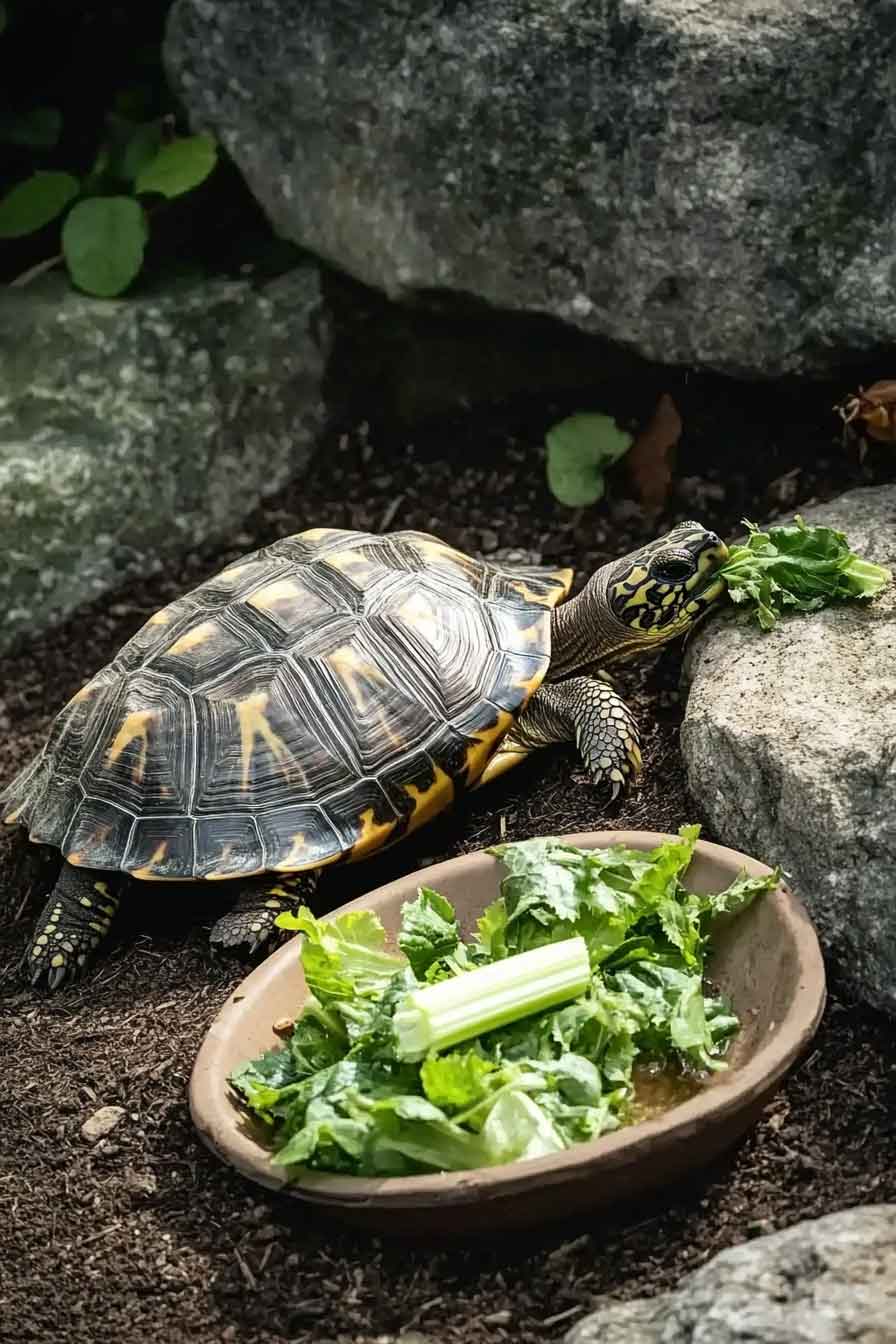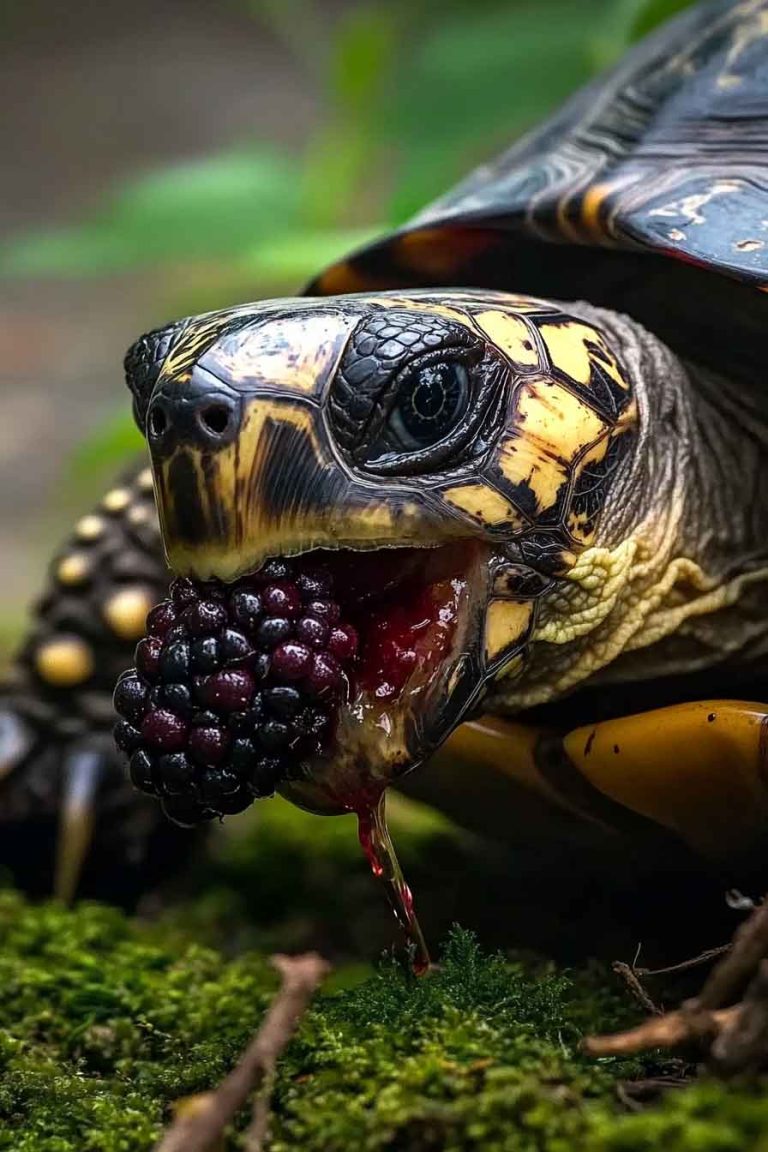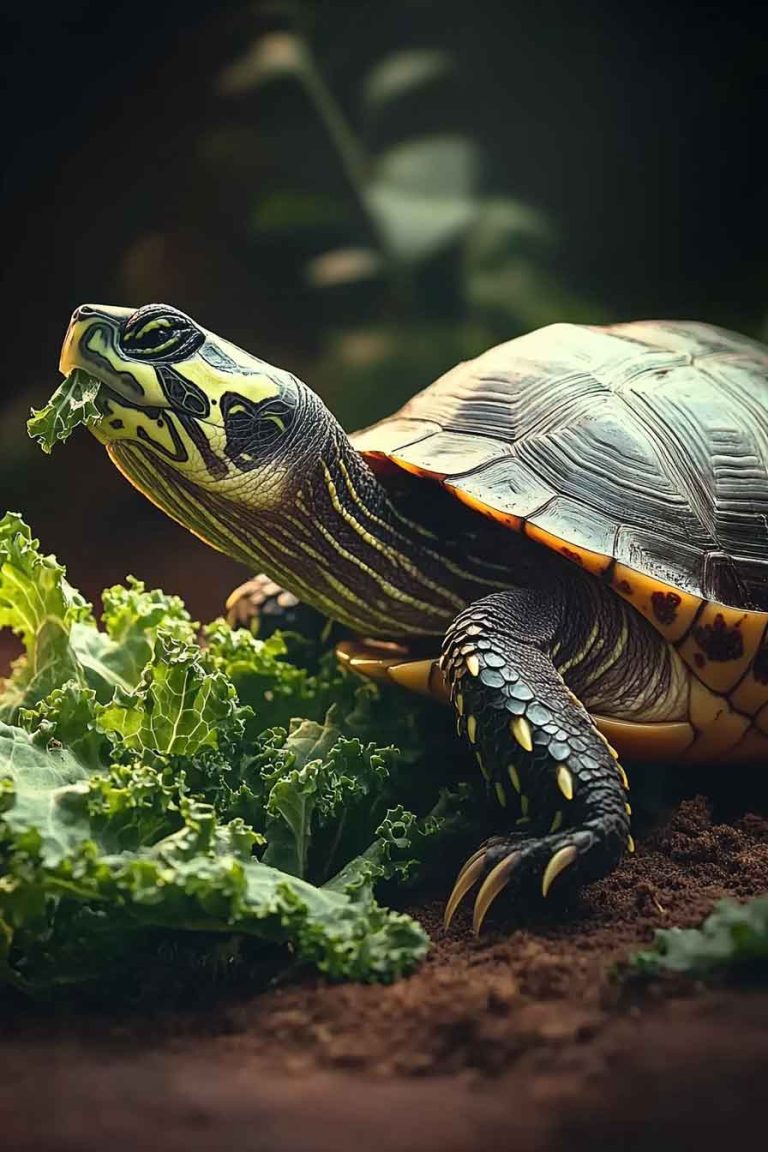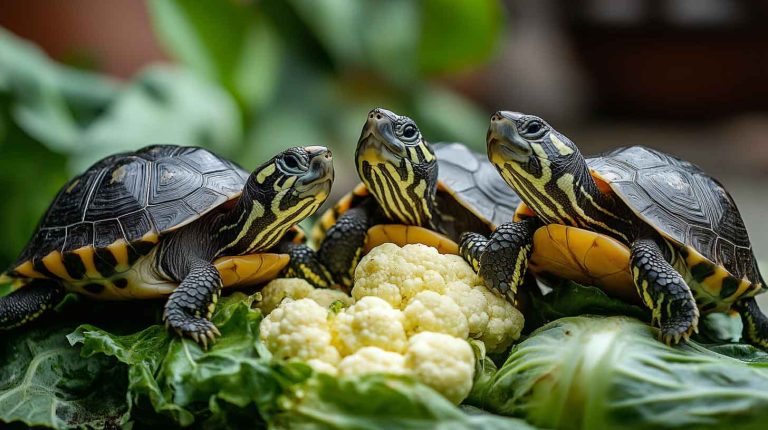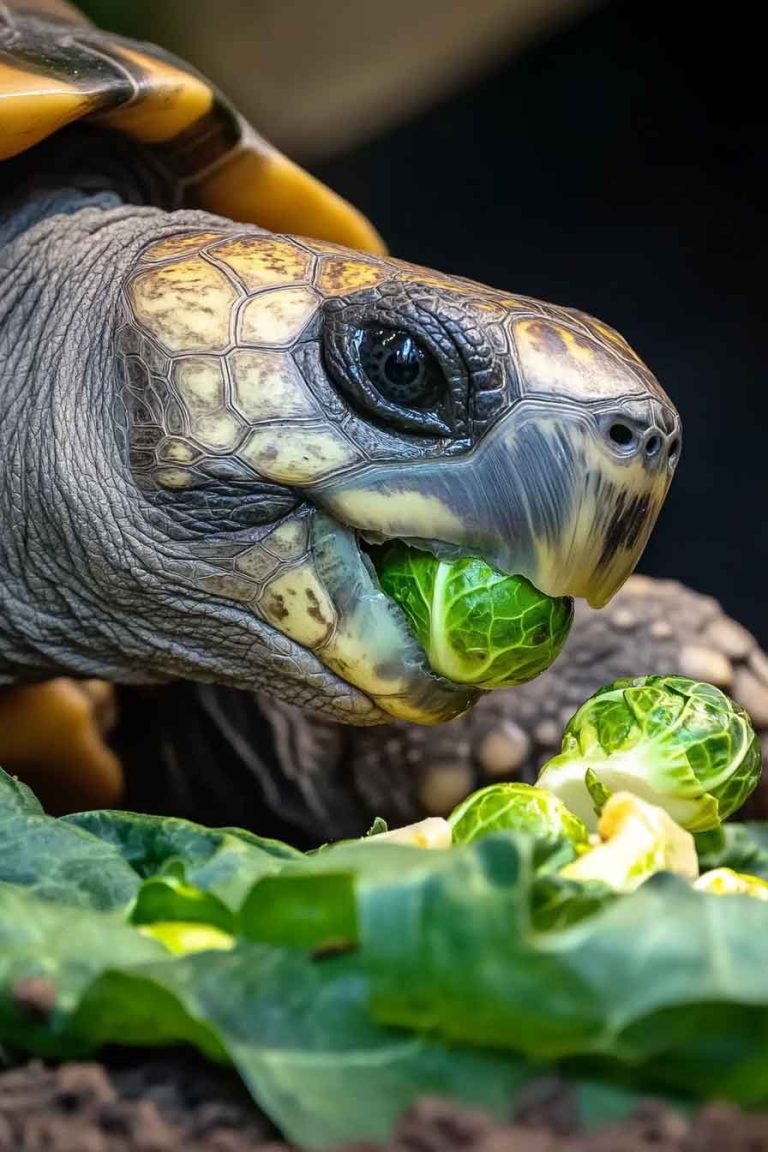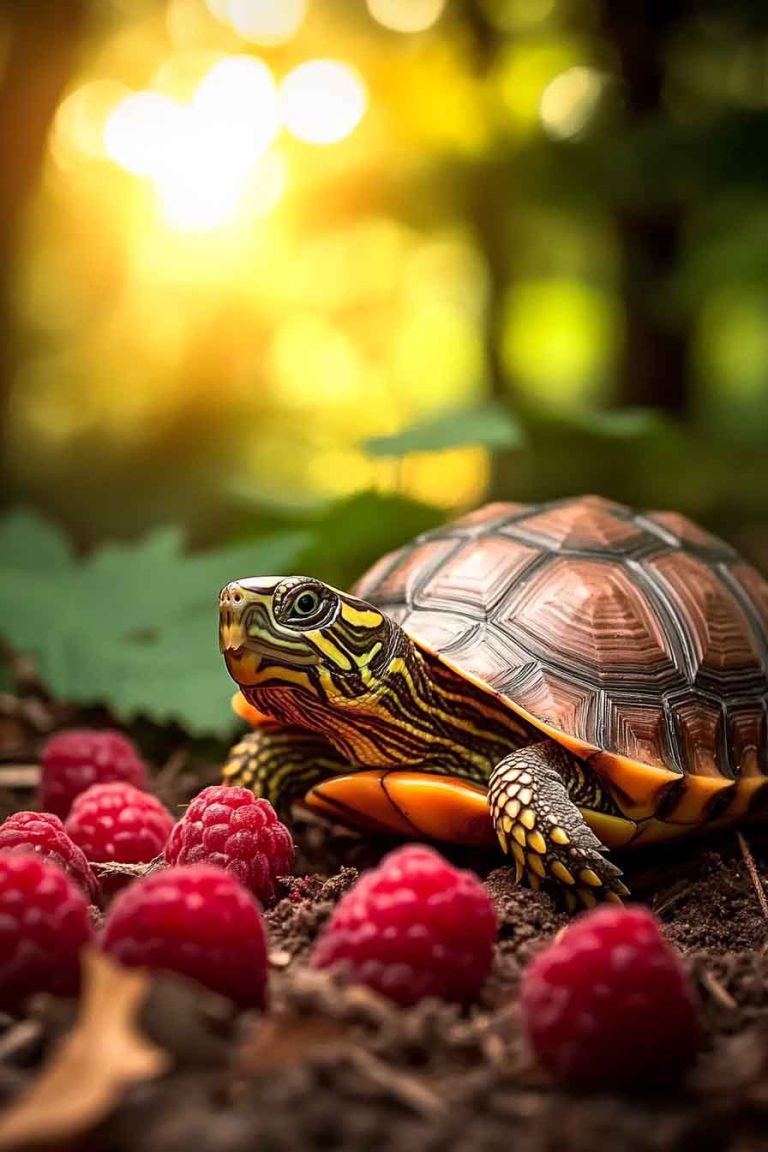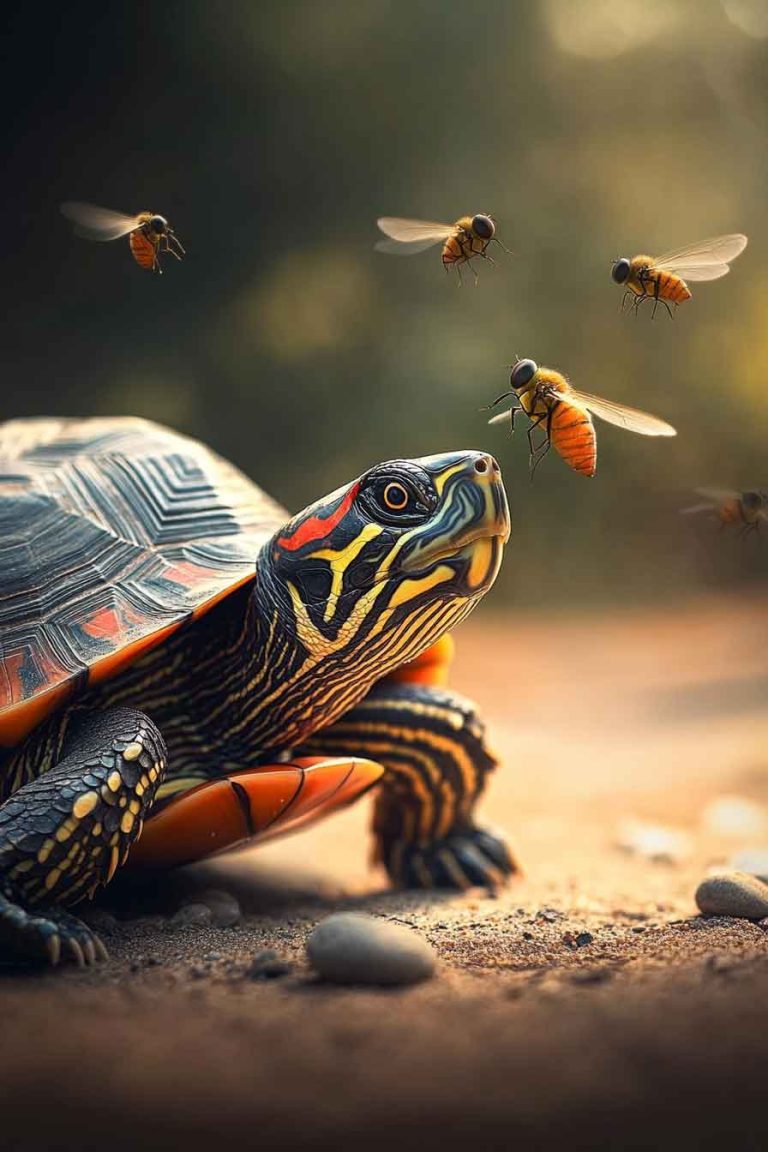Can Turtles Eat Celery? Safety, Nutrition & Feeding Tips
When I first got into turtle care, I tried to offer a wide range of vegetables to keep things interesting for my shelled buddy. One day, I had a bunch of leftover celery stalks in the fridge and thought, “Hey, this is green, crunchy, and low in sugar — maybe my turtle can have a…
When I first got into turtle care, I tried to offer a wide range of vegetables to keep things interesting for my shelled buddy. One day, I had a bunch of leftover celery stalks in the fridge and thought, “Hey, this is green, crunchy, and low in sugar — maybe my turtle can have a bite?”
But I wasn’t sure. I didn’t want to guess when it came to his health. So I did a deep dive — and what I found really surprised me.
So, can turtles eat celery?
Yes — turtles can eat celery, but only occasionally, in small amounts, and never as a main part of their diet. Celery is not toxic, but it’s very low in nutrients and has a few downsides that make it a poor choice for regular feeding.
In this post, I’ll walk you through what celery actually offers nutritionally, the pros and cons of feeding it, and exactly how I safely include it (if at all) in my turtle’s menu.
Can You Feed Celery to Your Pet Turtle?
Yes — but with caution.
Celery might look like a healthy vegetable — and for humans, it’s a low-calorie snack that helps with hydration and digestion. But turtles have very different dietary needs. Their bodies rely heavily on calcium, fiber, vitamin A, and a proper calcium-to-phosphorus ratio to support shell development, bone health, and digestion.
Celery is made up of over 95% water, which means it fills your turtle’s belly without delivering much nutritional value. When I first fed it, my turtle seemed curious. He crunched a piece or two, but quickly lost interest. It didn’t seem satisfying like leafy greens or protein-rich snacks.
That told me a lot: celery is not harmful, but it’s also not helpful.
Over time, I’ve learned that while celery can occasionally be used as a crunchy snack or part of a salad mix, it should never replace nutrient-dense staples like dark leafy greens, pellets, or high-calcium vegetables.
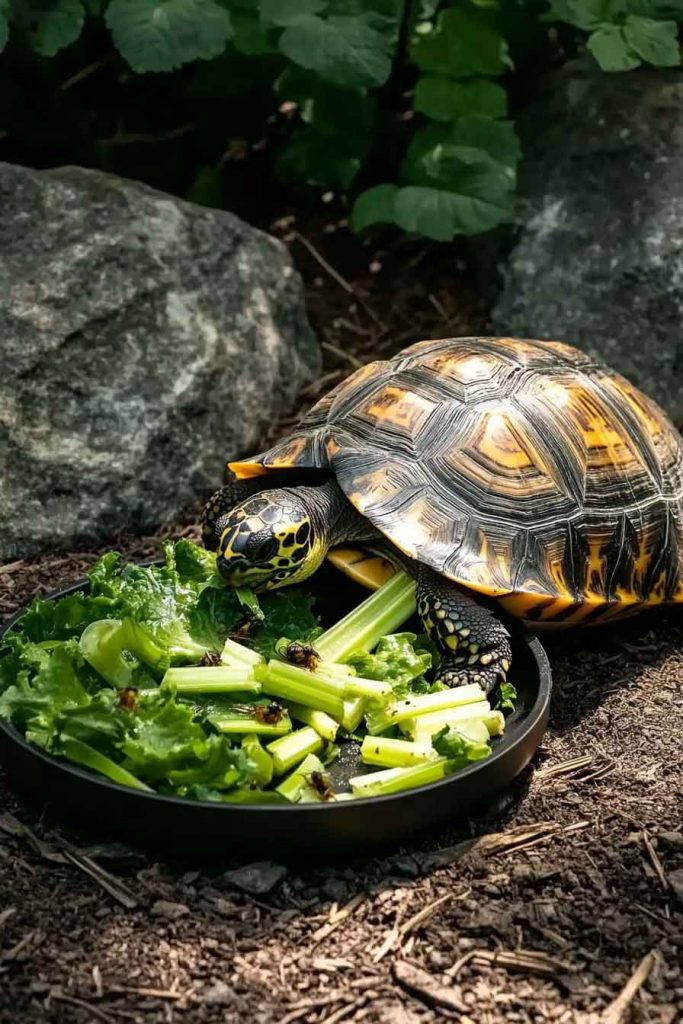
Nutritional Breakdown: What’s in 100g of Celery?
Let’s look at the typical nutrient profile of raw celery:
- Water: 95.4 g
- Calories: 14 kcal
- Protein: 0.7 g
- Fat: 0.2 g
- Carbohydrates: 3.0 g
- Sugars: 1.3 g
- Fiber: 1.6 g
- Calcium: 40 mg
- Phosphorus: 24 mg
- Vitamin A: 22 IU
- Vitamin C: 3.1 mg
- Vitamin K: 29.3 mcg
- Potassium: 260 mg
- Magnesium: 11 mg
- Oxalates: Present in low to moderate levels
Here’s the issue: while celery has a slightly positive calcium-to-phosphorus ratio (about 1.6:1), the absolute amount of calcium is very low. It also contains a fair amount of water and very little fat or protein — both of which are essential, especially for young or active turtles.
Also, celery contains oxalates, which are compounds that can bind to calcium and prevent its absorption in the body. This makes it even less useful as a source of this critical mineral.
So while celery doesn’t pose a direct health threat, it offers almost no real nutritional value to your turtle — especially when compared to vegetables like kale, dandelion greens, or turnip tops.
What Happens If a Turtle Eats Too Much Celery?
Feeding a little bit of celery now and then won’t hurt your turtle — but if it becomes a habit, there are real risks to watch for.
1. Nutritional Deficiency
The biggest concern with feeding celery too often is what it doesn’t offer. It doesn’t provide the calcium, vitamin A, or protein that turtles need. If your turtle fills up on celery, he may ignore more nutritious foods. Over time, this can cause:
- Calcium deficiency
- Shell softening or deformity (Metabolic Bone Disease)
- Fatigue or weight loss
- Eye swelling or infections (from lack of vitamin A)
I once gave my turtle a mix of watery veggies — including celery, iceberg lettuce, and cucumber — and thought I was doing great. A few weeks later, I noticed soft spots on his shell and learned the hard way: volume doesn’t mean value. Even if they eat a lot, they might still be undernourished.
2. Digestive Disruption
Celery contains stringy, tough fibers, especially in the stalks. If not chopped finely, those strands can be difficult for turtles to chew and digest. This is particularly risky for:
- Juvenile turtles with smaller mouths
- Older turtles that struggle with chewing
- Turtles that don’t drink enough water
Too much of that stringy fiber can lead to impaction (a kind of digestive blockage), especially in turtles that aren’t very active or well-hydrated.
When I do feed celery, I only use the inner stalks and leaves, and I chop them into tiny pieces — no long, stringy strips.
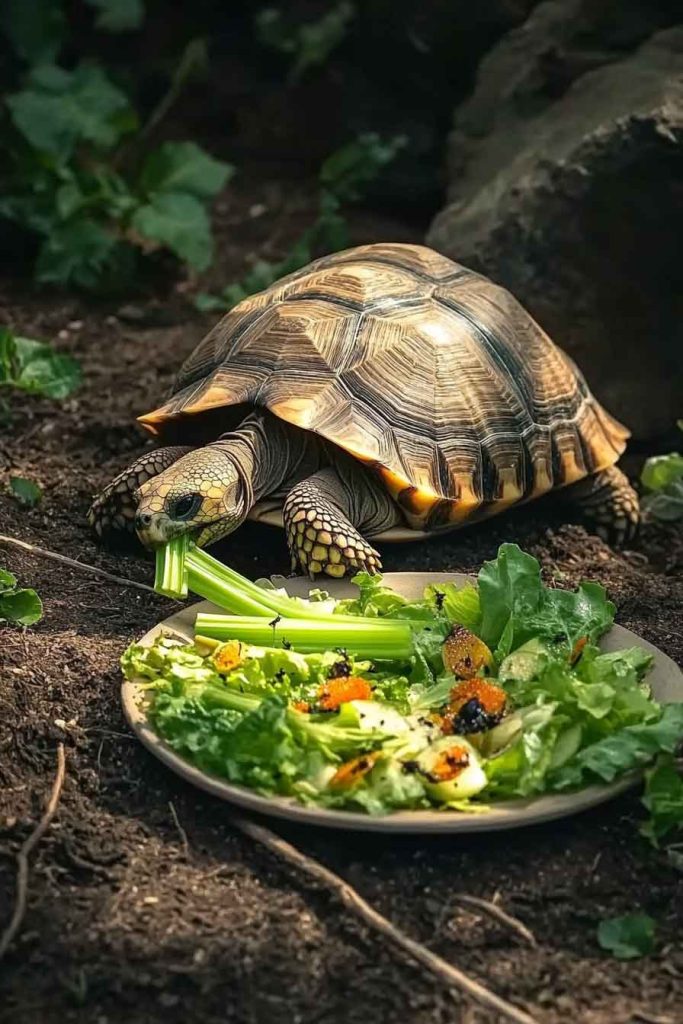
Do All Turtles React the Same Way to Celery?
Not quite. Different types of turtles have slightly different digestive systems and dietary needs.
Red-Eared Sliders & Painted Turtles
These semi-aquatic turtles are omnivores, especially when they’re young. They need a balance of plant and protein. Celery isn’t harmful, but it doesn’t help much either. I give my red-eared slider maybe one small bite every few weeks, mixed with leafy greens or carrots.
Box Turtles
Box turtles are land-based and lean more toward plants and fruits. While they can nibble on celery, they benefit more from dark greens, berries, and mushrooms. I rarely use celery for box turtles — it just doesn’t provide the fiber or nutrients they need.
Musk and Mud Turtles
These species are more carnivorous. They eat insects, small fish, and a little plant matter. Celery is not very appealing to them — mine barely touched it. I usually skip it altogether.
Can Baby Turtles Eat Celery?
No — it’s not a good choice for hatchlings or young turtles.
Baby turtles need more calcium, protein, and vitamin A than adults because their shells and bones are still developing. Celery can’t provide those — and the tough strings can even pose a choking or digestive hazard.
When I raised hatchlings, I stuck to:
- Hatchling turtle pellets (with D3 and calcium)
- Chopped greens like kale or turnip greens
- Tiny amounts of boiled egg or bloodworms
- Calcium dusted food twice a week
- Good UVB lighting for absorption
Celery? Not even once. There are just too many better options.
How to Safely Feed Celery to Your Turtle
If you still want to offer celery once in a while, here’s how I do it safely:
✅ Use It As a Snack, Not a Staple
I treat celery like a “filler food.” Just a few small pieces mixed into a salad-style bowl with nutrient-rich greens, like:
- Dandelion greens
- Mustard greens
- Romaine lettuce (not iceberg)
- Collard greens
I use celery no more than once every 2–3 weeks, and only in small amounts.
✅ Chop It Properly
Celery stalks are fibrous. I:
- Use the inner, softer stalks
- Remove the long, stringy fibers
- Chop it into tiny, bite-sized pieces to avoid choking or impaction
✅ Include the Leaves
Celery leaves are slightly more nutritious than the stalks. They have more calcium and vitamin A. If I’m using celery at all, I make sure to include a few leaves with it.
❌ Avoid These Mistakes
- Don’t use only celery — it’s too watery
- Never offer large chunks — turtles may choke
- Don’t feed to baby turtles — they need more protein and calcium
Frequently Asked Questions (FAQs)
Can Box Turtles Eat Celery?
Yes, but it’s not ideal. Celery doesn’t provide what box turtles really need — I prefer feeding them strawberries, mushrooms, and kale instead. Use celery rarely and always mixed with better vegetables.
Can Red-Eared Sliders Eat Celery?
Yes, red-eared sliders can eat small amounts. I use it as a mix-in, not a main food. They do better with aquatic plants, leafy greens, and commercial turtle pellets.
Can Musk or Mud Turtles Eat Celery?
Technically yes, but they probably won’t be interested. These turtles are more meat-focused, and celery isn’t worth the space in their bowl.
Can Baby Turtles Eat Celery?
No. Their growing bodies need high calcium and protein. Celery offers neither and may be too tough for their little mouths.
Conclusion
So, can turtles eat celery?
Yes — but it’s not the best choice.
Celery isn’t harmful, but it’s mostly water and fiber with very few nutrients. Turtles can eat a small amount every now and then, but it should never replace calcium-rich greens or high-quality turtle pellets.
Personally, I only give celery to my turtle once in a while, as part of a veggie mix, and never on its own. It’s crunchy, refreshing, and safe in small bites — but not something I’d count on for real nutrition.
Hope this post helped! If your turtle’s tried celery before, I’d love to hear how it went. Drop your story in the comments and let’s swap tips on what works and what doesn’t!

